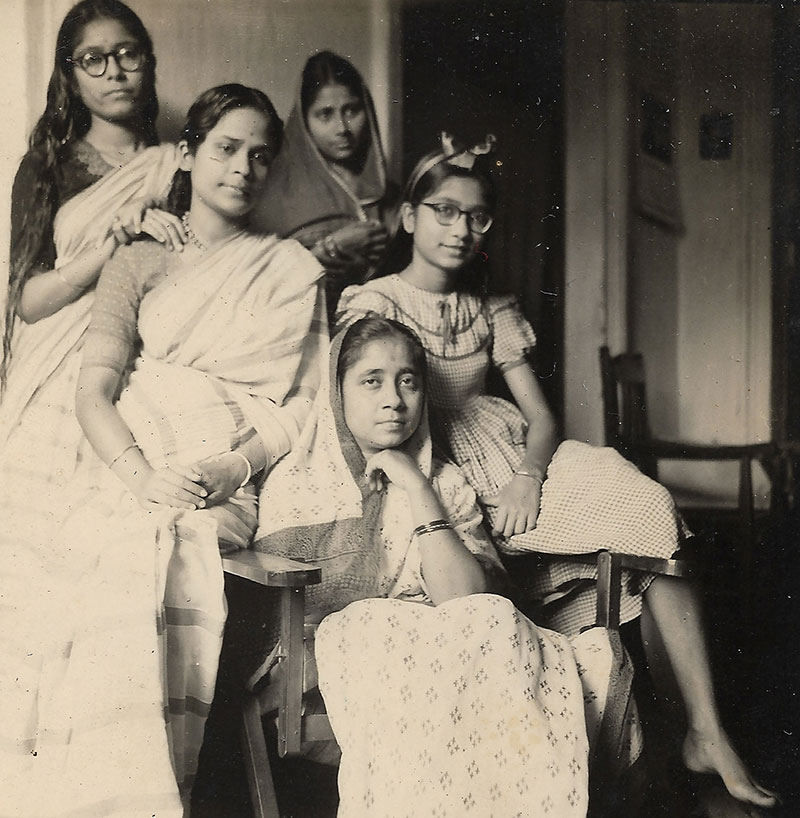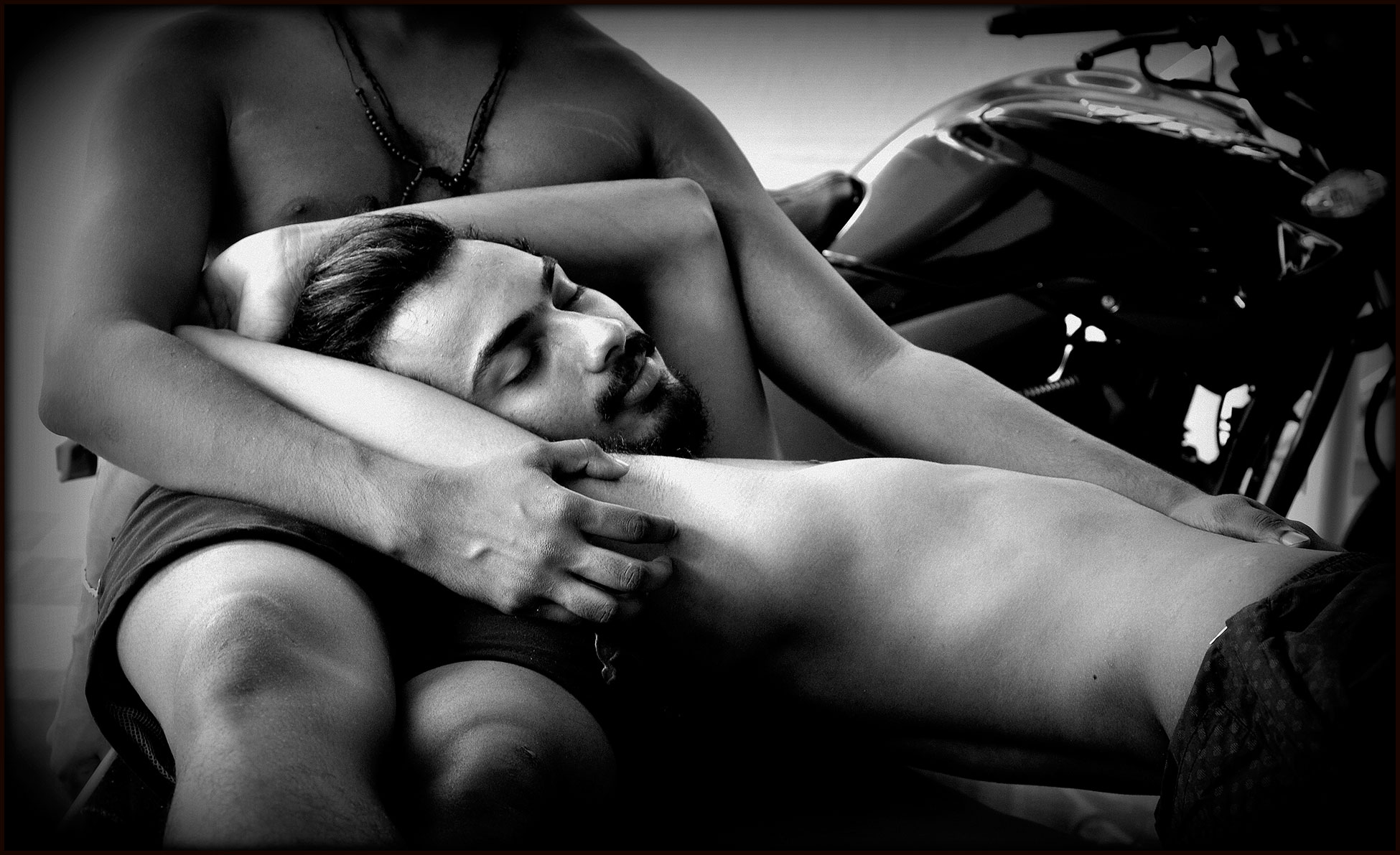Zoom In
Festival Review
PhotoMail constructively and
Critically zooms into
The life and work of photographers
Its art and techniques
Contemporary theory
Aesthetics, material philosophy and
Sociology
Gautham Ramachandran
reviews
Indian Photography Festival 2018
Also, an exclusive
Editorial by Abul Kalam Azad
Read Part 1 of the
review here
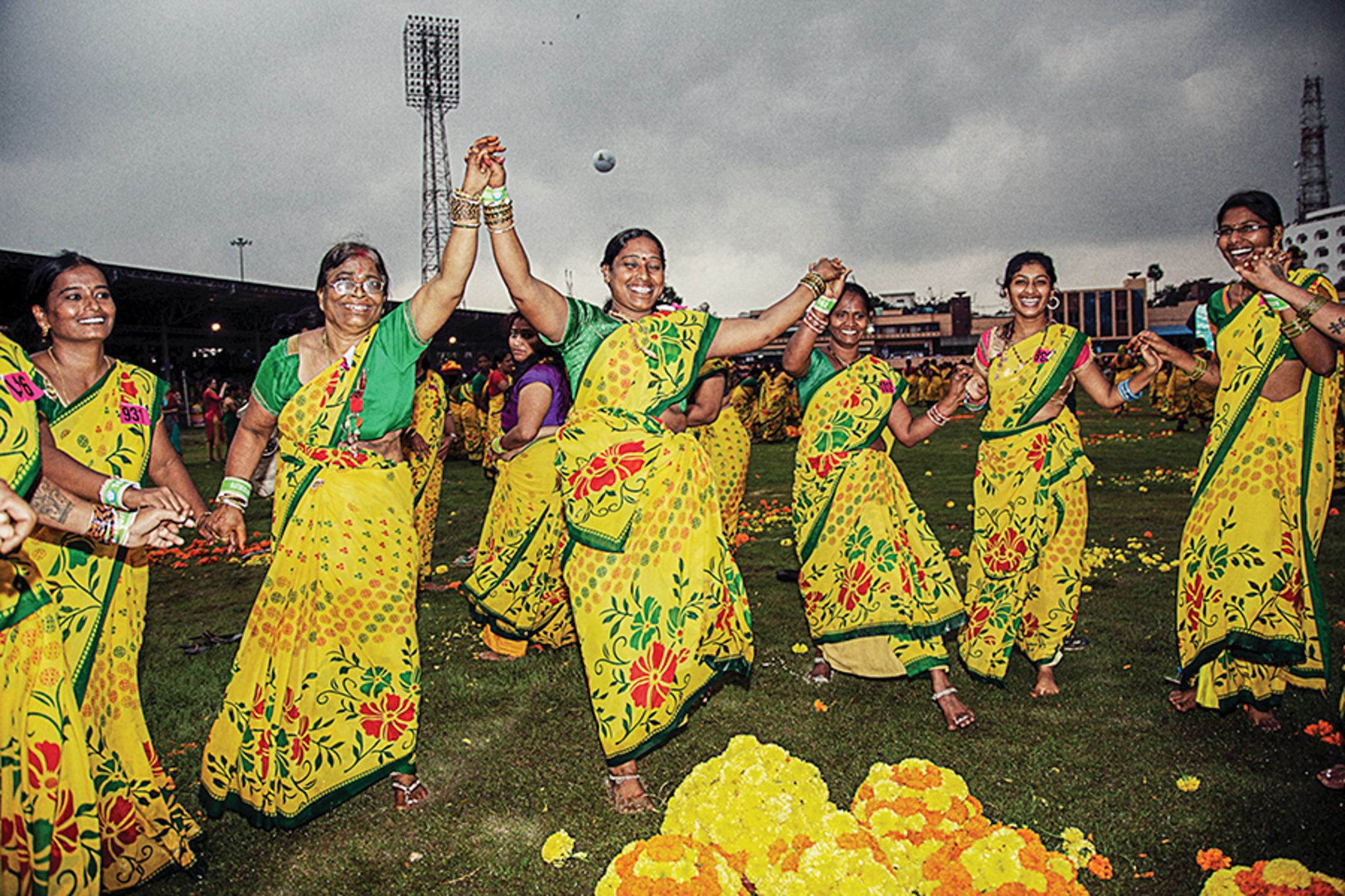
Bathukamma exhibit at Indian Photo Festival
Indian Photo Festivals
Business As Usual Part II
Over the last 180 years, throughout the life of photography, photography in India has had quite a few takers, with its number of practitioners spiraling in the last decade alone. Nonetheless, it seems that we haven’t carved a special niche in the world of photography. At this point, “photographs taken in India” seems to be the only category in Indian photography, with no meaningful genres, movements, or schools within it. Technologically too, maybe except the invention of dry plates, which was done by the Britishers themselves to suit the Indian hot climate, there is nothing as such that could be hailed as India’s contribution to the world of photography. At the same time, the other art forms have produced masters who can rub shoulders with many of their western contemporaries – think of Ramkinkar Baij, K G Subrahmanyam, K C S Panicker, Ritwik Ghatak, O V Vijayan, Pandit Ravi Shankar, the Progressives (to name only a few immediately recognizable people), who have made their unique marks, in spite of various shortcomings. The Indian photography of this same period has only been a pale imitation of what was happening in the Europe and the US; or they continued to carry out photographic practices that were associated with the nobility. In a way, these two are connected. If one looks at the origins of documentary photography, it was carried out as an act of an outsider looking down on a powerless group. The photographers who imitated the western trends did this under the guise of “humanist” aesthetics, and those who continued the practices of the nobility did it quite openly. This second stream is in the process of dying out and the humanist stream is becoming nearly universally followed. In addition, we haven’t been able to produce even a single photographic historian/theoretician who could influence the International decision makers and make them reconsider the kind of photography they promote. As a result, our reliance on galleries and other such market-oriented entities has only increased disproportionately.
What has contributed to this state of affair is the most pertinent question that every photo-enthusiast must ask. One reason that is quite obvious is that photography was introduced by the Britishers, during their reign to propagate their moral values and assets. It is only natural for one to follow their teachers and most of the colonial period native photographers too imitated their foreign masters. But, like many other practices that have stuck even after independence, the ones in photography too have become a curse, so to say. Breaking away from the chains of colonial gaze and representation is becoming a difficulty for most of the Indian photographers. Almost too often, photographers armed with their camera document the under-privileged or stalk the streets. These images do not communicate to the people who make up the subject matter of such projects. They have to be content with being photographed and with getting a place in front of a rich crowd who will symbolically look up to them for a few seconds. It is a cruel consolation offered in return to being exploited, both by the artists and by the system. As far as the photographers are concerned, they are the privileged caretakers who take it upon themselves to “take care” of the representation of a few yielding subjects; these subjects are usually the poor, the tribals, the spiritual gurus, the pilgrims, the devotees, and the crowded streets. The buildings will be magnificent, the people naïve and the land attractive, as found in colonial photographs.
Objectively looking at this situation, the Indian identity is relatively new. It was only as part of the Independence struggle, this land that is indeed a conglomeration of different history, culture, tradition and lifestyle took on the collective image with the “Spiritual India” cap. Mind it, this idea of India was a notion prescribed by the British Royals. At the time of independence, one of the key concern of the Indian leaders was that every development in this country were a contribution made by the colonials and that there was nothing as such “Indian”. India has spirituality, was the response and the same stereotype has since been emphasised – “In India, anybody you see could be a guru in disguise”. This idea of “spirituality” is again drawn from a narrow range of mythologies which were developed in the Indus-Ganges plains. Naturally, it became necessary to subscribe to these to be called Indian. The South, the North-East and the Himalayas are almost totally excluded from this India, unless a Vedic link is made.
I think, this has a lot to do with the apparent gap in Indian photography. We continue to subscribe to this idea of spiritual India and its material poverty, that religion has taken precedence over the pluralistic lifestyle and indigenous tradition of the land. This land has seen several invasions and each power has had the histories written and rewritten, with changing alliances leading to several layers of oftentimes conflicting identities. The pan-Indian identity strived to sideline all such regional histories, and globalization furthered this process. For example, most of the memory photography projects stop with that of partition and refuse to go farther back. Works based on regional histories which enriched and influenced the local sociopolitical formation are not common. It is as if the photographers have also lost their way in the collective amnesia that curtails one from seeing today’s culture as a conglomeration of years of interexchange. Indian history prior to 1857 has been comically reduced to an imagined golden age which existed two or three or five thousand years ago, and this history has no means of explaining what exists today. Under this corrupted notion of history lies the whimsical and fetishizing gaze of the colonial who thought he owned this land.
This trend is being continuously reinforced by the market, which only wants more of the primitive, spiritual India that is familiar for it. Works that get the exposure are ones that are disconnected from the life of the photographers, and those which fit established stereotypes. The market prefers mainstream narrative, and so do international photographers and jury members, who do not have deep knowledge of the local context and of the contributions of Indian photographers outside the international circuit. The works which do not have any marketable qualities, but are valuable as cultural documents, find no support. Effectively, we let the market determine what photographic documents of today survive for tomorrow.
Most Indian festivals are more keen on employing foreign photographers as jury, and claim foreign participation and foreign acknowledgement as the highest of achievements. It is natural that such personalities form an image of India from what the market tells them India is, since it is through the market that what is known as Indian photography reaches them. Regional photography and regional histories, especially those of the South and the North-East are rarely understood, as they are effectively excluded from the idea of India. Nor are international festivals keen on exhibiting fresh and experimental work from India. For them, their regional photographers are more important and Indians are only included in such festivals as token representation. It is as if Indians are there for the sake of diversity, to be seen as ones needing support and recognition from the richer countries. It is natural that only works which repeat the ideas of the modern West or the ancient Orient will be allowed to surface at such venues.
I see this as neo colonialism at work. What the selling points were for colonial photography, remain the same today. This endless loop that keeps photographers and organizers of the festivals in a certain track is cause for worry as far as the medium is concerned. The worst part of this loop is that it is no longer being substantially challenged by the “discourse”. The onus is on us, the ones who are having our representations narrowed, to break away from this trap. Otherwise, we will be playing a lost game. Unless we make our mark in the world of photography, Indian Photography Festival or any such names, will only be just names, for the purpose of market.
– The Editor
Orientalism is the exaggeration of differences, the presumption of Western superiority, and the application of cliched analytical models in describing the Oriental world – comprising of Asia, Northern Africa and the Middle-East. It can be described as a persistent Eurocentric prejudice against the Orient’s people and their cultures, and reduces them to fictional “essences” of themselves. These cultural representations usually depict the ‘Orient’ as primitive, irrational, violent, despotic, fanatic, and essentially inferior to the westerner, and hence, ‘enlightenment’ can only occur when “traditional” and “reactionary” values are replaced by “contemporary” and “progressive” ideas that are either western or western-influenced.
In 1978, Edward W. Said published his seminal text, Orientalism, in which he examined the prejudices of the Western nations in their assimilation and dissemination of knowledge about the Orient[I]. As far as the medium of photography is concerned, extensive studies have been carried out in showing how the colonial empire had used it as a tool of domination, under the guise of anthropological objectivity (fuelled by the writings of Max Muller and the likes). The photographic archives of India created by the British administration were tailored to fit these narratives as a justification for a ‘benevolent’ colonisation of the land.
71 years after gaining independence from colonial rule, India is now emerging as one of the leading exporters of services to the West – and this has again given rise to a stereotype of it as a land of IT firms and call centres. But, this “modernity” is confined to very limited spaces of urban cities, with financial inequality broadening the gap between various classes in society. This increasing gulf, seen throughout the world, colours the urban culture as a global, ahistorical, ideal culture – and those outside this global culture come to embody whatever is regional; this “outside” can be anything from the slums of Mumbai or Rio to the unclaimed wildernesses. A new ‘Otherness’ (the split between the West and the East, modernity and tradition, civilised and barbaric, etc.) is produced, somewhat outside the realm of the traditional ‘Other’- this phenomenon that acts almost like a “new Orientalism”. The ‘Other’, now exists outside the “modern society”, as opposed to western civilization. The ‘Indian’ part of Indian Photography Festival, that is on display in 12 venues across Hyderabad, is an example of how this new ‘Otherness’ is working. It is materialized throughout the total of 10 solo exhibits (out of the overall 25), and one group exhibit (out of the 10) are either shot by a photographer identifying himself as Indian, or by foreign photographers in India – together accounting for almost one-third of the total exhibits.
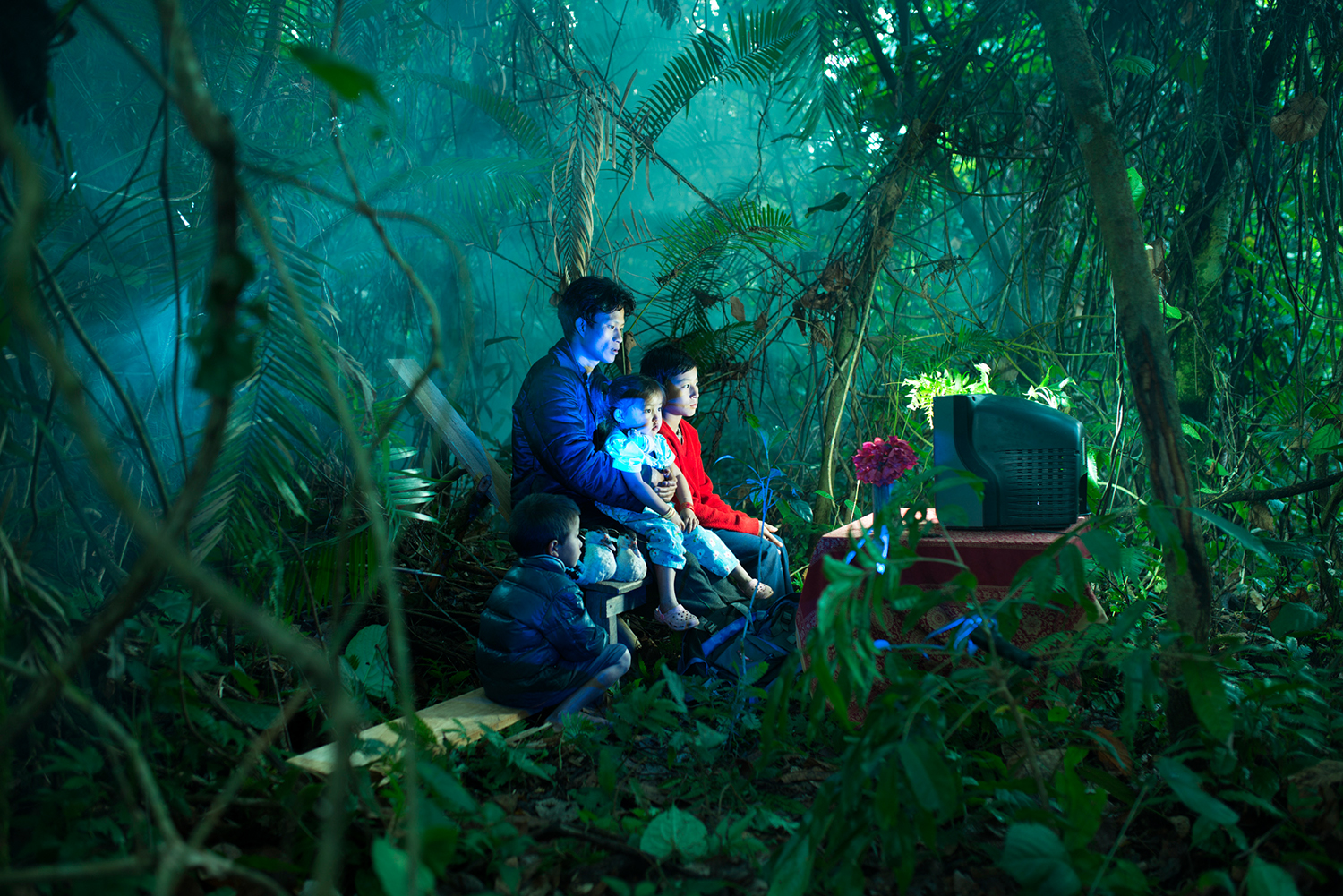
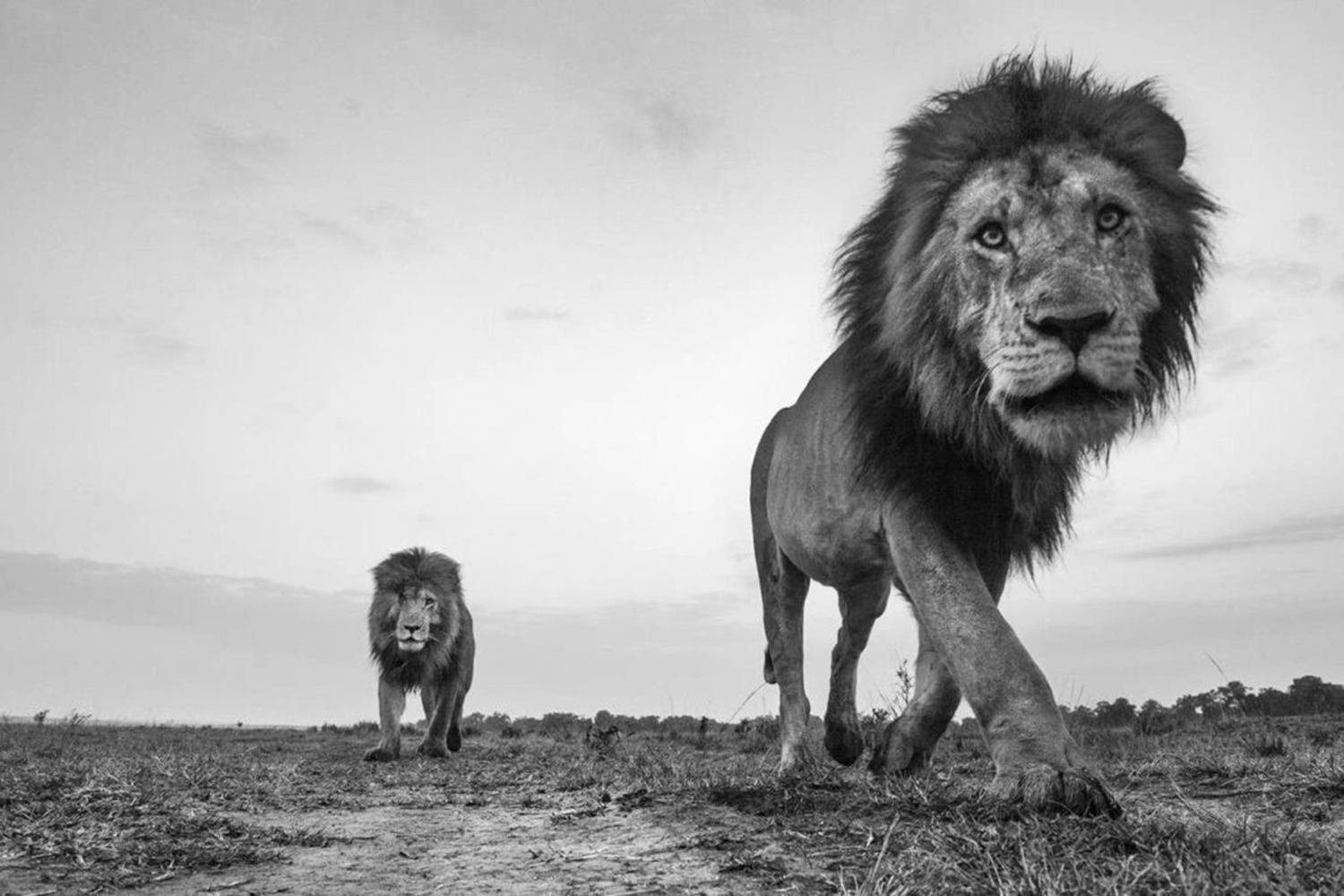
Image 1 Imagined © Sharbendu De | Image 2: Masai Mara Park © Anup Shah
Anup Shah’s photographs of the Masai Mara Park are perhaps the loudest example of this projection of ‘otherness’ – an Indian photographing the exotic animals in Africa, and showcasing it to the ‘modern’ viewer – a true heir to the colonial photography culture. The genre of wildlife photography was instituted as a method to catalogue and study animals by the colonialists. The Masai Mara has been a ‘focus’ of wildlife documentaries as far back as 1909, when Cherry Kearton was producing glass-plate negatives of African fauna. Anup caters the same ‘fantastical’ landscapes of Africa to the global viewer, in much the same manner that Kearton had for the British. Selected “because it gives a different perspective, and the photographer has gone close to the animals (by using drone cameras)”[II], the aesthetics of the images themselves seem much like those employed by nature-documentary channels on television – something that Reza Deghati, a Nat Geo photographer and also a jury member in IPF, should have been all too familiar with. The amount of time and money expended on such undertakings around the world betray something quite different to the usual scientific curiosity that is cited as the reason for wildlife photography; it reflects a more basic, historical, drive in man to capture nature and possess it in bits and pieces; and wildlife photographs seem to be the new tiger skin, the new ivory tusk, and the new stuffed animal head. Anup Shah does little to counter this.
Rohit Chawla’s series is a selection of celebrity portraits, ostensibly shot for magazines and other such publications. This exhibit can only be a meek attempt to present these portraits as serious art, following the model of how figures like David Bailey, Irving Penn, Robert Mapplethorpe, and others have been inducted into the art discourse. A similar case of commercial photography being retrospectively adapted to art is seen in Mahesh Shantharam’s series on (rich/upper-caste/Vedic) weddings. They are both products of the photography industry, and have no identity or meaning in an artistic sense. Harsh as it may seem, both of them must be written off as an attempt to find cultural value in what is ultimately a product; and this hazy cultural value is being searched for in the global culture.
Archetypes were initially built by observers who are on the ‘outside’, to classify a subset of people. It points to the tribal origins of early civilization, through the depiction of a group of people using broad and exaggerated behavioural, physical, and cultural traits, which later evolved/were adopted to the class divisions, and the construction of other identities. In essence, an archetype is a collectively inherited unconscious idea of forms, and archaic patterns and images. In Jungian psychology, they are a set of unclear underlying ‘potentials’ which enable categorization of images through the interpretation and assimilation of history, culture, and personal context. An archetypal image is the set of symbols and motifs that draw on these underlying forms through the production of mythologies.The image of Bharat Mata as a representation of the embodiment of India, as depicted by Abanindranath Tagore during the Nationalist Movement, is one such archetypal image. It signalled the idea of India as a territorial nation being represented by its majoritarian traits. Ravi Varma’s depiction of saree-clad women can be cited as another example – but, in this case, it is the scale of reproduction and relentless repetition of these images that ultimately converted it into an archetype of the ‘chaste Hindu woman’ who wears a saree, which was until then a garment worn only by the royalty. R K Laxman’s depiction of the common man in his comics draws on pre-existing archetypal images to create a new one, whereby a whole nation is represented in one single image – an old, bespectacled, balding man in a shabby coat, and dhoti, with a look of perpetual bewilderment on his face. The motif of the dhoti combined with the overcoat was initially associated with a class of ‘gentlefolk’ who worked in the emergent sectors of modern society during British Raj, as doctors, professors, engineers, etc. The most obvious problem of the production of most archetypes is that they have already been produced, and now it’s only a matter of re-production. In the context of images being produced by photographers, the reproduction of archetypal images often provide no further purpose – the images of manual scavengers shot by Enrico Fabian, a German photographer, and Sudharak Olwe (who was part of the jury in this edition of IPF), both serve the same purpose of highlighting the issue of manual scavenging, which has by now turned into an archetype by itself; one which embodies the whole of caste oppression. The photograph of a manual scavenger at work, looking helplessly at the camera, or an image of his body covered in human excrement, is the ultimate appeal today to end the caste system. Yet, we rarely see what happens “behind” this blatant caste oppression, how such atrocities continue to happen in the broad, 21st century daylight, and why whole communities face the brutality of the system – it tells us very little about what is wrong. Herein lies the second, more deeper problem with archetypes; they can only show you the surface, and never what is “behind” the surface; they restrict themselves to the outward symptoms, and never reveal the disease.
‘Everyman’, another series by Enrico Fabian, comprises of the “quintessential” portraits of the ‘common man’ – struggling with poverty, discrimination, and still living on the ‘outside’ of modern India. ‘Everyman’ both others and typecasts its subjects, fitting the portraits into the idea of India as a primitive country. Prabhakar Kusuma’s ‘Destitute’ series (shot in 1993) employs a similar, sympathetic gaze – depicting helpless people, mostly women, in shelters. Unlike Fabian, Kusuma has no qualms of using overt symbolism that invoke imageries of Deliverance. In Christian mythology, the idea of deliverance arises out of an underlying criticism of humanity’s transgressions on tradition, whereby they are condemned to a life in struggle before the innocent are rescued by a merciful ‘saviour’. The style of Chiaroscuro is apparent in Kusuma’s images – to exaggerate the archetypal dynamics of ‘light and dark’, as representations of the dichotomy of such narratives as good/evil, happiness/desolation, faith/hopelessness, etc. Developed by Italian painters during the Renaissance, it was a technique that used artificial lighting to enhance the three-dimensionality of forms and the drama playing out in an image – with the sources of light often being linked to divinity. The photograph focusing on the cross, in particular, can be read as an allegorical (and cliched) reference to the deliverance promised to the poor and the orphaned. The series, as a whole, is quite loud in its attempt to evoke sympathy for its subjects, although it is unclear what follows after the evocation of sympathy. In the end, the series remains a collection of empty images of powerless subjects, shown to us to make us witness their desolation.
‘Primitivism’ has been a prominent aesthetic and ideological trope of western art, borrowing from typically non-European cultures that were perceived by the West to be ‘primitive’ (as the name suggests). The utopian ideal, towards which Primitivists aspire to, lies in a notional “state of nature” in which their ancestors existed, or the supposed conditions of the people that live beyond modern civilization – such as in Henri Rousseau’s paintings. Sharbendu De’s images ‘play’ into the same archetypes as the Primitivists, as he strives to depict a world of man intertwined with nature – a mythical land, which the modern world has removed itself from. The Lisu tribe in Arunachal Pradesh, which lives in a state of perpetual disregard by the government, is transformed in De’s images as a community inhabiting a surreal dreamscape, which according to him, tries to evoke an aura of their mythical world, reference archetypal interconnections between man, animal and nature, and borrows from dream symbolism. According to De, traditional photojournalistic approaches have had no impact in bringing the struggle of these communities to the attention of the government, and that is the reasoning behind his conscious employment of surreal imagery. But, again, the question remains as to what the prerogative is? Does being aware of the archetype negate its purpose? The problem of speaking for others has been discussed by Deleuze. This does not mean, of course, that one should refrain from speaking at all, but the speaker has to be aware of the the effects of the speech on the audience. In De’s case, he is showing us our own myths about the ‘exotic’ lands of the Lisus – but where are the mythical lands the Lisus dream for themselves? How does the re-iteration of an already existing myth contribute to the deconstruction of the same? His parallel documentary series based on the same subject, which was not exhibited at IPF but can be found online, is quite ironic; in the sense that it shows us what they “really are” – and how they “really are” is nothing like how his “conceptual” and “poetic” representation makes them out to be. The unspectacular documentary series, however, offers us a glimpse into what is happening – how the photographic representation of a people is becoming more and more unapologetically about ourselves and our ideas, rather than about them. The underlying problem is still the same – the self-representation of the people is absent in this conversation. While the efforts to empower and provide representation to these marginalized communities may be backed by laudable intentions, the rhetoric that arises out of these movements has to be examined. For example; in a 1994 essay, United Nations Secretary-General Boutros Boutros-Ghali wrote that “It is now clearly understood that many indigenous people live in greater harmony with the natural environment than do the inhabitants of industrialized consumer societies” – perfectly summing up the fetishized view of such peoples and their lifestyles.
These representations have a very disturbing voyueristic side to them – it is eerily similar to a virtual tour of these locations, which only exist as myths in the minds of the viewer. According to Dean MacCannell, outright postmodern tourism sought to “reject” mass-packaged tourism due to its lack of personality by seeking out the ‘authentic’ that resided in primitive, rural, and undeveloped areas. The post-modern tourist travelled to rural areas and slums to escape his/her own crushing existential crisis in the ‘superficial’ and ‘inauthentic’ industrialized society. This immersion in a more ‘primitive’ society enables the contemplation/reflection of one’s own identity in modern society when confronted with the life of these “others”. In this contrast between two conflicting ‘ideals’, the “other”, that only serves as a temporary foil to re-affirm the the first ideal, is called a “vanishing mediator”[III]. The photographic image of desolation, therefore proves to re-affirm the urban man’s ‘privilege’, and makes him content in his life. The emergence of ‘Slum tourism’ in the underdeveloped and neglected streets of Rio de Janeiro, Mumbai, Johannesburg etc. is an example of this idea. Slum tours are typically three hours long guided tours done on foot or in a vehicle. Most tours offer tourists the chance to enter the homes or businesses of slum residents, where a guide, fluent in English, would describe the experience of slum life. Due to language barriers, slum tourists do not generally interact with local residents directly or through the tour guide. Many tours, including those in Rio de Janiero and Mumbai, also bring tourists to the rooftop terrace of a slum house, where they get a panoramic view of the entire slum. But, these are again pseudo-events, which are mere simulations of reality and narratives being peddled to capitalize on the market demands. The perversely romanticized images of squalid and desolate conditions, especially in cinema, only serve to relieve the urban population from its own sense of despair. The slum tourism business in Mumbai saw a 25% increase in the aftermath of the release of Slumdog Millionaire in 2008 (ref: WorldHum Weiner, 2009), while similar trends were observed in connection with the release of City of God (Rio de Janeiro), and District 9 (Johannesburg). This plays back into the same disillusionment Europeans were struggling with at the height of the Industrial age. The old destinations of escapist fantasies have now been re-located to these ‘outliers’ of modern urban cities, rather than the lands that had been newly colonized at that time.
The threat of globalization homogenizing the urban society also leads people to a sense of dislocation from their personal and cultural identity. The newly formed Telangana state achieved its autonomy through the ruling Telugu Rashtra Samiti’s relentless campaigns calling for a separate state for economic autonomy and the preservation of Telugu identity. In line with this ‘ideology’, the party declared ‘Bathukamma’ as a State funded festival. Bathukamma, a variation of the Autumn-harvest festivals that are celebrated all over South-Indian states, received over 200 crore in funding in 2017 (if media reports are to be believed), with the govt. undertaking the task of distributing over one crore sarees to the women of Telangana. The backdrops of these intense identity politics and government propaganda are sacrificed in Hiro Tanaka and Barbara Davidson’s simplistic portraits of the Telugu women celebrating the flower festival (the ‘focus’ of these images will be dealt with in another article). The exhibit’s only claim seems to be the involvement of the photographers as a ‘clever’ coming together of the West and East. The only way this could be more comical is if all three cities – Hyderabad, and the photographers’ own hometowns – all lay on a straight line. The writings that accompany these amateurish photographs, elevating the festival to a mystical and exotic tradition which ‘purifies’ nature, does nothing but exacerbate this sense of comedy – which actually makes you question if the whole thing is a tongue-in-cheek affair. It can only be construed as the same old philosophy of ‘exoticisation’ in a bid to market the images to a ‘tourist’ audience in the same manner as Henri Cartier-Bresson, famous in India for his photographs of Ramana Maharshi, had claimed that he saw a ‘fireball’ descending onto the Annamalai hill at the time of Sri Ramana’s passing. These are typical travel photographs, much in the same attitude as Prudhvi Chowdhary, whose imageries are again, impersonal. The photographs of the Charminar, India Gate, and people are much in the same perspective as colonial documentations – where the humans are only in it by coincidence, as a faceless mass, or to be used for scale. They prove to be more of an advertisement of the locations themselves rather than personal stories of travel.
The Indian Photography Festival certainly leaves one wondering about what is so Indian about it; if it is, as claimed, only a geographical marker, how does one account for the large regions that are left unrepresented? One has to hazard a guess as to what really constitutes this Indianness, and if the claims are kept aside and the images surveyed, we are confronted with the truth of this Indianness – it is a construction rooted in what can be called a “global culture”, and can shapeshift into whatever is needed of it. It can become a poverty-stricken land which the urban people must save, a land of myths and rituals, a part of the world where labour is cheap and the people are stupid, a vast expanse of lush and varied landscapes, and nearly anything else. It is also clear what one must do to partake in the enjoyment of this Indianness – escape from India and look at it as a global citizen; one is then able to project all his/her nostalgia, desires, dreams and fears onto the large cluster of Indians who seem to scramble amongst themselves to survive. This constructed India is of no use to the subjects that comprise it. It is solely meant for the people who are outside it, and like a vanishing mediator, it manifests only to reaffirm their own sense of belongingness in the world, in one way or another. The photographs of India, or by Indians, exhibited at IPF are only slices of this vanishing mediator.
[I] Said’s assumptions sparked off a very controversial debate that is still very much relevant today, because orientalist discourse is still greatly influencing the cultural production of the West, be it academic or artistic. In popular culture, a recent example of this is given by the Hollywood movie 300, released in 2007, which narrates the resistance of a handful of Spartan warriors against the Persian invasion during the battle of Thermopylae. In this American blockbuster, the portrayal of the Spartans has no reason to envy Leni Riefenstahl’s aesthetics, while the massive ‘Asian’ horde of invaders is depicted as barbaric and monstrous. This was raised as an issue in the UN. The ‘Other’ is still very much an important focus in visual representation. – from ‘REPRESENTING THE OTHER’ TODAY: CONTEMPORARY PHOTOGRAPHY IN THE LIGHT OF THE POSTCOLONIAL DEBATE (WITH A SPECIAL FOCUS ON INDIA) by Philippe Calia. [II] Interview with Aquin Mathews, Director, Indian Photography Festival by Gautham Ramachandran. [III] This is explained in detail by Slavoj Zizek in his analysis of James Cameron’s Titanic, where Lenonardo di Caprio’s working-class man character serves as a ‘vanishing mediator’ to restore a sense of identity and purpose to Kate Winslet’s spoiled, high-society girl character. In his critique of James Cameron’s “Hollywood Marxism”, Zizek calls out the reactionary myth lurking behind the superficial sympathy for the poor – as in Rudyard Kipling’s Captain Courageous, where a young rich person gets their vitality restored by a brief intimate contact with a full-blooded life of the poor. In his own words: “What lurks behind [this] compassion for the poor is their vampiric exploitation”.

Gautham Ramachandran is an upcoming artist who works with Photography, Printmaking, and Painting. He is a graduate of The Govt. College of Fine Arts, Thrissur where he received his degree in Painting, and completed his Masters in Printmaking from the SN School of Arts and Communication, Hyderabad.
Published on October 8, 2018
Share
Related Articles

In my taxi, when a photo artist becomes a cab driver
What motivated Weideman to keep photographing? The answer to this is also an important quality that makes his photographs intriguing. He continued shooting even though he was not exhibiting nor getting into any sort of limelight until the mid-90s. Passion for the medium, of course. But there is more.
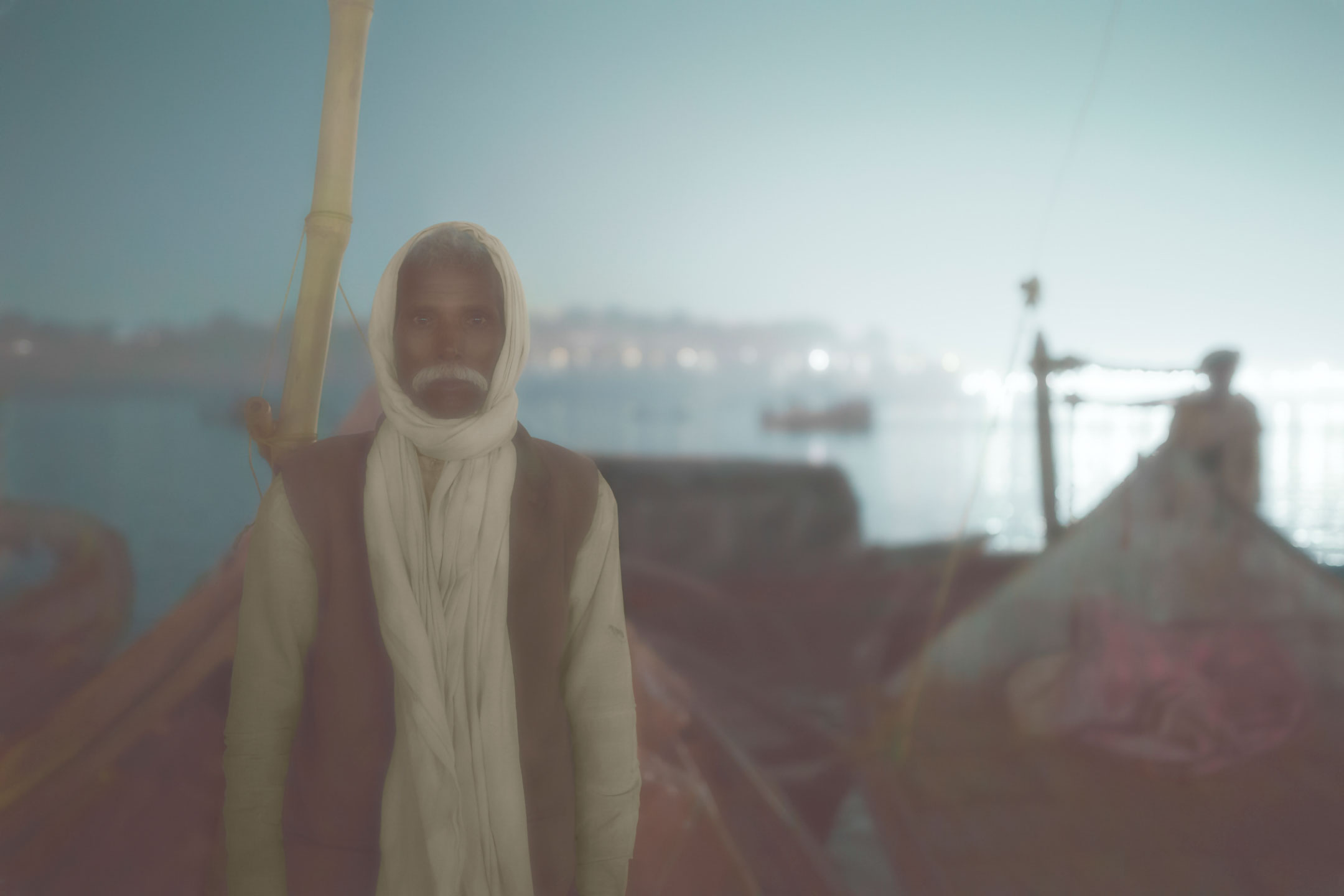
Mallaahs, the boatmen of Gangetic geography, A Photo Art series by Shibu Arakkal
Review of Mallahs, the boat of Gangetic geography, photographic series of Shibu Arakkal. For several hundred years these boatmen on the Ganga and the Yamuna have handed down their oars from father to son. I was intensely drawn to the purpose of their lives, to carry people back and forth on these rivers. Almost married to their boats, these men. To live almost all of their lives on these wooden vessels, going about their worldly chores and belonging to a tribe of menfolk, they pride themselves on being the real caretakers of these mystical rivers. Almost as if they are born on these boats and just as possibly may breath their last on it, the Mallaah men live lives removed from their families and children.
In search of the lost home
Across the world there are ongoing attempts to construct a ‘people’s history’ through photographs. Memory Projects, they are fondly called, focus mainly on the pre-digital era when photography was not as common as today. Bengali photographer Anandarup Goswami’s photography series ‘A Home of No Return’, though not directly linked with any memory project, shows certain resemblances with the latter’s style, and yet carries its own soul. A Home of No Return visually narrates the past and the present through a mixture of faded and fresh photographs.
Homomorphism II
The LGBTQ community has found for itself public spaces in urban regions. We will wait and see what they want to tell the world from that space. After all, solidarity with the cause does not mean solidarity with the acts, and it is time for the community to begin to act convincingly. This exhibition is a good starting point, and further on, there is a desperate need for clarity on the part of the activist-artists.

Elements and Fragments, Uncovering Narratives of a Temple Town
Inasmuch, every photographer that ever visited Tiruvannamalai never took notice about anything other than Ramana and the Annamalaiyar temple – their eyes glossing over everything else and their focus devoted entirely to the two ‘divine’ icons. But, there remains a Tiruvannamalai beyond, which has gone unnoticed and undocumented – invisible to the colonial gaze that is pre-occupied with its exotic fairy tales, and underwhelming for the photojournalist due to its perceived mundane-ness.


